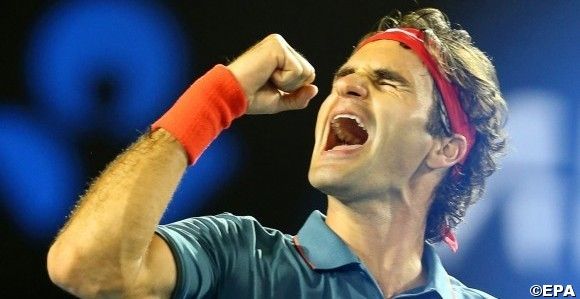Federer, King Of Kings by Ed Billett
 Federer, King Of Kings by Ed Billett
Federer, King Of Kings by Ed Billett epaselect epa04036193 Roger Federer of Switzerland celebrates after defeating Andy Murray of Britain in their quarter final match at the Australian Open Grand Slam tennis tournament in Melbourne, Australia, 22 January 2014. EPA/DAVID CROSLING AUSTRALIA AND NEW ZEALAND OUT |
“My name is Ozymandias, king of kings: / Look on my works, ye Mighty, and despair!”, so reads the famous quotation from Percy Bysshe Shelley’s ‘Ozymandias’. These words, of course, turn out to be hollow, as all that remains of Ozymandias’ works are the decaying remnants of a once flourishing empire, and all that remains of Ozymandias himself are ‘two vast and trunkless legs of stone’, standing idle in a barren desert which once served as the territory for his ruling dominion. The inscription bearing Ozymandias’ words thus function as an ironic fossilisation, imploring the reader to despair of a king now gone, and his works lost to the ravages of time. In short, the poem is about idolised figures, survival, and the transience of even the mightiest of men.
It is during these first few weeks of the year, watching Roger Federer, that this poem struck me as remarkably poignant. The 2014 tennis season has been under way for some weeks, and one of the chief topics of discussion has been the speculation regarding the form of Federer. 2013 served for many fans as a reminder, not dissimilar from Shelley’s tale of Ozymandias, that even the greatest of us are subject to the transience of time. Following each early exit, startling loss, or poor performance, many were quick to point out that, like Ozymandias himself, Federer was not impervious to the effects of time, his empire not immortal as it once appeared.
Yet this year, barring Federer’s disappointing loss to Lleyton Hewitt at the Brisbane International, there have been signs that Federer has transcended these transient effects. When the draw was revealed for this year’s Australian Open, it was made apparent that Roger would have to defeat Tsonga, Murray, Nadal and Djokovic in order to win the title, a task which appeared almost insurmountable given Federer’s sub-standard performances in much of 2013. Advancing to the semi-finals, Federer triumphed over both Tsonga and Murray in 3 and 4 sets respectively, with stunning performances described as Federer being in ‘full-slight’, ‘vintage’, or ‘2006 Federer’. Indeed, Federer’s aggressive game plans were executed with a precision that echoed the past form fans know he is capable of.
It remains to seen whether Federer can beat both Nadal and Wawrinka (having knocked out Djokovic) to win his 18th Major title, though fans will be calling for him to employ more ‘vintage tennis’ if he is to do so. It is hard to argue against Federer employing the aggressive tennis he has thus far, but this idea of reverting back to past form, resisting the transience of time, is an interesting, and perhaps also reductive view of Federer’s game. To say that Federer played akin to that of ‘Federer 2006′ (a curious idea in itself, withholding an abstract mental conception of Federer c.2006), perhaps doesn’t given Federer full credit for his play. To say ‘this is vintage Federer’, or ‘Federer of 2006′ negates the work, experience and tactical evolutions of Federer’s game, changes he has implemented to keep pace with the likes of Djokovic and Nadal. To say ‘this is Federer of 2014′ is perhaps more appropriate – wielding his larger racquet and now under the tutelage of Edberg, ‘Fedberg’ is arguably more dangerous than he has been in the past, having two top ten victories already, and astute tactical advice from his new coach and former idol.
Topics: 10sballs, Andy Murray, Australian Open, Brisbane, Jo Wilfried Tsonga, Lleyton Hewitt, Novak Djokovic, Rafael Nadal, Roger Federer, Sports, Stanislas Wawrinka, Stefan Edberg, Tennis, Tennis News


10sBalls Top Stories
- Deneme Bonusu Kampanyaları ile Yatırımsız Kazanç Sağlama
- 2024’ün En İyi Bonus Kampanyaları Hangileri?
- Hoşgeldin Bonusu Almanın Avantajları
- Güncel Deneme Bonusları: Hangi Sitelerde Mevcut?
- 2024 Yılında Deneme Bonusları Veren Sitelerin Özellikleri
- Deneme Bonusu İle Eğlenceli Slot Oyunları
- Efesbet Lisansı: Kayıtlı Olduğu Kurumlar
- Почему Отказывают В Выплате Dragon Money?
- Драгон Мани Играть На Деньги! Мобильная Версия Доступна Уже!
- Казино Комета (Kometa) официальный сайт, войти через рабочее зеркало
- Онлайн казино Комета (Kometa): лучший выбор для игроков
- Зеркало Kometa Casino | Рабочее Зеркало для Входа в Комета Казино 2024
- Казино Банда Зеркало
- Казино Банда (Banda) Официальный Сайт, Войти Через Рабочее Зеркало
- Банда Казино Мобильная Версия Официальный Сайт Banda Casino
In Case You Missed It

Официальный Сайт Банда Казино Casino Banda: Регистрация, Вход И Бонусы ️ Играть Онлайн На Официальном Сайте Banda Casino
Официальный сайт Banda Casino регистрация вход
Banda Casino Зеркало – Рабочие Зеркало На Сегодня Банда Казино
Актуальные рабочие зеркала казино Банда на
Banda Casino Зеркало – Рабочие Зеркало На Сегодня Банда Казино
Обновленное зеркало Банда казино на сегодня
Как Войти В Онлайн Казино Банда?
Как начать играть в онлайн казино




